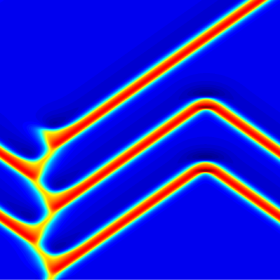Publications
| Abstract | It is well known that excitable media can sustain “fast” stable traveling pulses of excitation. In models for which analysis is tractable, the fast pulse solution is known to appear through a saddle-node bifurcation accompanied by a “slow” unstable traveling pulse. Furthermore, the uniform rest state is also a stable solution. It is generally assumed that the boundary between the basins of attractions of the rest state and fast pulse (i.e. threshold) consists of the stable manifold of the slow pulse. We use numerical experiments to explore this issue. Our results indicate that, near the saddle-node bifurcation, the stable manifold of the slow pulse does indeed act as the threshold between the rest state and fast pulse. However, further away from the saddle-node bifurcation, a global bifurcation involving the heteroclinic connections between slow and fast pulses occurs. This bifurcation gives rise to an unstable periodicsolution that has been referred to as a one-dimensional spiral wave. Beyond the bifurcation point, the stable manifold of the one-dimensional spiral wave appears to act as the threshold between the rest state and fast pulse. |
|---|---|
| A link to the paper |
 SIAM J Appl Dyn Sys, to appear (2.6MB) |
| A bigger version with higher quality images: pdf (10MB) |